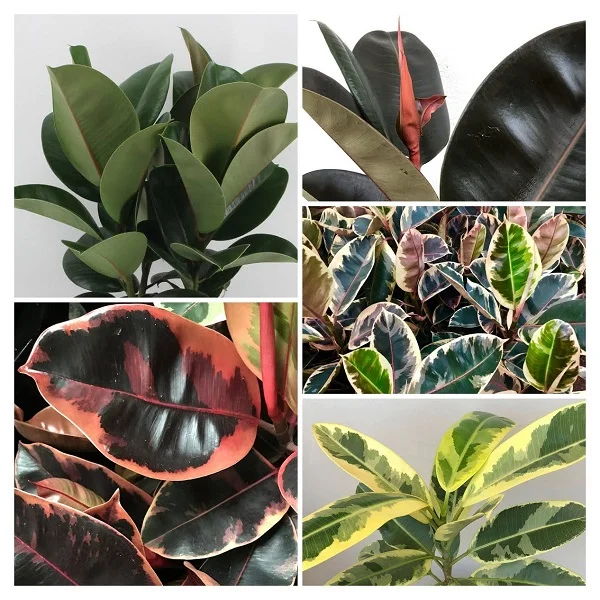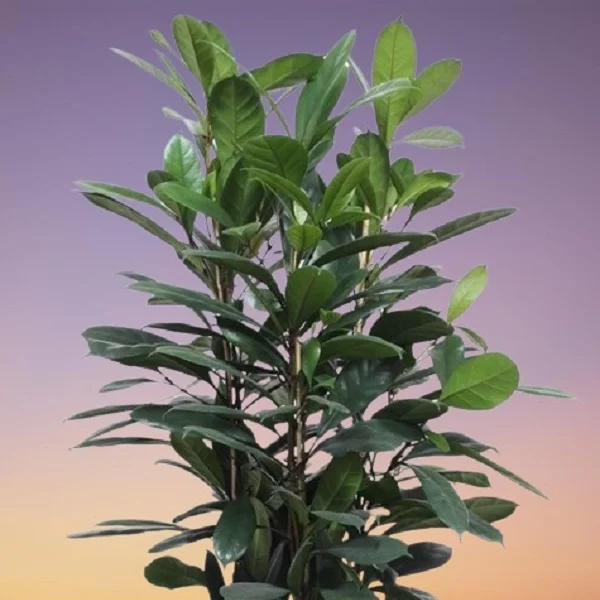How to Grow and Care for Ficus Alii (Banana Leaf Fig) Indoors
Some links in this post may be affiliate links
Ficus maclellandii 'Alii' blossoms in bright light with some direct sunlight, average humidity, moderate humidity and moderately moist, rich well-drained soil coupled with monthly feeding in the growing season.
If you are searching for a houseplant that brings a touch of sophistication without being overly dramatic, Ficus maclellandii 'Alii' is your bet. Ficus maclellandii 'Alii' also called Ficus Alii, Banana Leaf Fig, Banana Leaf Ficus, Long Leafed Fig or Narrow Leafed Fig is one of the popular Ficus varieties ideal for indoor growing.
Banana Leaf Fig is an evergreen, perennial plant with glossy, long, slender, willow-like, medium-green leaves which hang downwards. The new leaves are reddish-bronze and change to medium-green as they mature.
The plant has two type of leaves where leaves on lower leaves are narrower than the leaves on higher branches. These leaf characteristics make this plant one of the best plants for an office space as they create a spectacular sight.
Banana Leaf Ficus is considered more tolerant of indoor growing conditions than its cousin Weeping Fig as it rarely sheds leaves and tolerates lower light better.
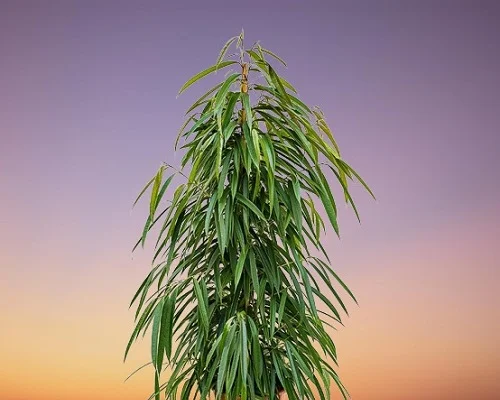
Botanical name: Ficus maclellandii 'Alii'
Family: Moraceae
Common names: Ficus Alii, Banana Leaf Fig, Banana Leaf Ficus, Long Leafed Fig, Narrow Leafed Fig
Origin
Ficus maclellandii 'Alii' is native to Asia, India and China. Ficus Alii is a cultivar which was originally introduced in Hawaii and was given the name, 'Alii'. It is often labelled as Ficus binnendijkii or Ficus longifolia in plant stores. Another cultivar of Ficus maclellandii is Ficus Amstel King which was developed in Holland and is considered more hardy than Alii.
Size
Banana Leaf Fig can grow to a height of 9-10 feet and 3-5 feet wide when grown indoors which make it ideal for filling the large spaces or an empty corner. It is one of the best indoor trees for the home, office or any suitable space.
Toxicity
Like other plants in the Moraceae family, Ficus maclellandii 'Alii' is toxic to humans and pets as indicated by Pet Poison Helpline. It produces a milky white latex which is an irritant to the eyes and the skin. If ingested it can cause irritation in the mouth, drooling, vomiting, diarrhea, loss of appetite and abdominal pains.
Where to Buy
Would you like to add Ficus Alii to your collection? You may get these plants online from Etsy (Link to Etsy).
Ficus maclellandii 'Alii' Care Indoors
In this guide, we will cover everything you need to keep your Alii Fig thriving indoors, from lighting and watering to propagation and common care mistakes. Let’s dive in.
Ficus maclellandii 'Alii' flourishes in bright light with 4-6 hours of direct sunlight, average warmth of 16-250C, moderate humidity of 50-55% and moderately moist, fertile, well-drained, all purpose potting soil coupled with monthly feeding during the growing season. Keep reading for a detailed account on these growing conditions and how to provide them.
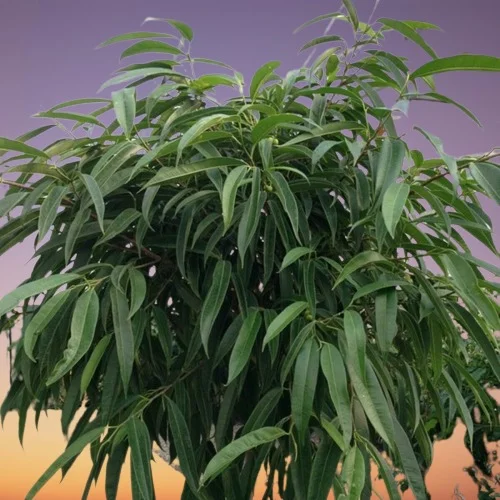
Watering
Water Ficus Alii liberally during the growing season until water comes out through the drainage holes and allow the top 2-3 inches of soil to dry out between waterings to keep the soil moderately moist.
Decrease watering during the cold season to maintain the soil barely moist as growth is reduced at this time. Use room temperature water as cold water can cause reduced growth and leaf drop.
Make sure that the pot has a drainage hole to prevent the soil from getting soggy as it can cause leaf drop and root-rot disease.
Long Leafed Fig is sensitive to chlorine and other chemicals dissolved in water. Use only chlorine-free water to avoid spots on the leaves. Learn more on how to water houseplants.
Light Requirements
Ficus Alii grows best in bright light with 4-6 hours of direct morning or late afternoon sunlight. Avoid exposing the plant to hot direct sunlight as it can cause sunscorch (brown) marks on the leaves and eventual leaf drop.
Banana Leaf Fig can adapt to lower light conditions but it will grow much slower and may lose its variegation. If light is too little it may cause yellowing and leaf drop.
Where the natural lighting is insufficient you may grow the plant under a grow light. Check out these full spectrum grow lights on Amazon.
Turn the pot regularly to ensure that the plant receives light on all sides for even growth and avoid lopsided growth.
Temperature and Humidity
The best temperature for Ficus Alii is an average warmth of 16-250C. Keep it away from drafts to prevent sudden changes in temperature as they can cause leaf drop.
Moderate humidity of 50-55% is ideal for Banana Leaf Fig. However, if the air is too dry especially where temperature is high, set the pot on a wet pebble tray or use a cool mist humidifier to elevate humidity.
Clean the leaves regularly by damp-wiping with a soft cloth to get rid of dust and also discourage pest infestation.
Feeding
Feed Ficus Alii every 4 weeks during the growing season with a balanced, water-soluble fertilizer to encourage lush growth. Do not feed in the cold season as growth is minimal and feeding at this time can cause fertilizer burn.
Potting Soil
Ficus Alii is best potted in soil that well-drained and rich in organic matter. These will prevent it from getting soggy while providing the required nutrients. Most all purpose potting mixes are ideal for the plant.
Repotting
Repot Ficus Alii at the beginning of the growing season only when it has become root-bound. Repotting every 1-2 years is adequate for this plant. Avoid frequent repotting as it prefers to be pot-bound. Repot only when it has outgrown its current pot; when roots begin to grow through the drainage holes.
Use a pot 1 size larger and one that has a drainage hole to prevent the soil from getting soggy. Never allow the roots to sit in soggy soil as it can result in leaf drop and root-rot. Take a look at this ceramic pot with drainage hole and saucer on Amazon.
For a large Banana Leaf Fig which may be difficult to handle, annually replenish the top 2-4 inches of soil with fresh soil while taking care not to injure the roots.
Pruning
Pruning Ficus Alii is easy. Remove dead and yellow leaves to maintain the plant neat and tidy as well as discourage pests and diseases.
When Long Leafed Fig has reached maximum height or it has become leggy, cutback the branches to rejuvenate growth and also encourage a bushy, compact growth. You may use the foliage emanating from the pruning to propagate new plants.
Propagation
Ficus Alii (Ficus maclellandii 'Alii') can be propagated during the growing season by air layering or by stem and stem-tip cuttings.
How to Propagate Ficus Alii by Air Layering
Air layering involves notching the stem of a healthy Ficus Alii and coating the notch with a rooting hormone to promote rooting.
Surround the notched area with damp moss and cover the notch with a polythene film or clear plastic wrap.
Once the roots have formed, sever the stem just below the covered part. Remove the polythene or plastic wrap and carefully pot the rooted cutting in moist well-drained soil.
Ascertain that the pot has a drainage hole to prevent the soil from getting soggy as it can lead to rotting.
New shoots will sprout from the shortened stem of the old plant into a beautiful bushy plant.
Place the new Banana Leaf Fig in a warm, brightly-lit spot and maintain the soil moist until the plant is well established after which you can begin routine care.
How to Propagate Ficus Alii from stem cuttings
Take non-woody stem or stem-tip cuttings about 6 in. long from a healthy Ficus Alii. Strip off the lower leaves from the cutting and retain 2-3 leaves on top.
Allow the sap to dry and then dip the lower cut end cutting in a rooting hormone to hasten rooting.
Insert the cutting in moist rooting soil and ensure that the rooting container has adequate drainage to prevent the soil from getting soggy to avoid rotting of the cuttings.
To enhance rooting of the cutting, create a mini-greenhouse by covering the set up with a clear polythene bag or sheet.
Ensure the leaves do not touch the bag or the sheet too much by propping it up with sticks.
Place the set up in warm, brightly-lit spot and maintain the soil moist through out until new growth emerges.
New growth indicates that the cutting has rooted. In about 3-4 weeks, rooting will have taken place.
Gradually over a period of two weeks, remove the plastic cover to acclimatize the new plant.
In 4-6 months, there will be adequate root development and you can transplant the new plants into individual pots after which you can begin Long Leafed Fig routine care.
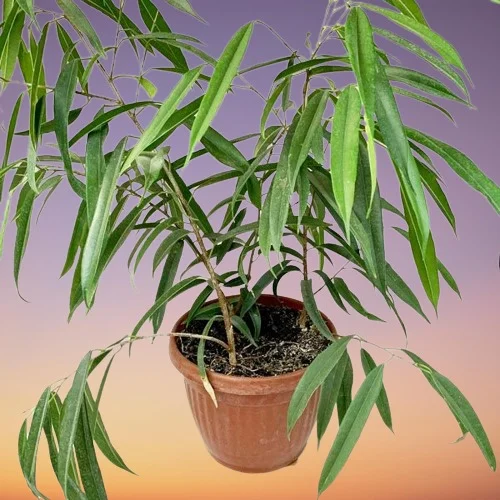
Ficus maclellandii 'Alii' Problems
Ficus Alii (Ficus maclellandii 'Alii') problems are brought about by cultural faults and include leaf drop, brown leaves, drooping leaves, diseases and pests among others. Keep reading for more details on these problems and how to fix them.
Pests
The common pests in Ficus Alii are aphids, mealy bugs, scales and spider mites. Isolate the affected plant to prevent spread to other plants. Learn how to identify and get rid of pests in indoor plants.
Diseases
Ficus Alii is prone to root-rot disease which is enhanced by soggy soil. Ensure there is free drainage of both the soil and the pot and also reduce watering during the cold season.
Leaf drop (loss)
There are many and varied causes of leaf drop in Ficus Alii. One possible cause of leaf drop is sudden changes in the growing conditions. This is likely to occur when you bring the plant home or when you move it to a new location in the home.
When you bring the Ficus Alii home, place it in bright light with 4-6 hours of direct morning or late afternoon sunlight and warm conditions. Water it liberally during the growing season while allowing the top 2-3 inches of soil to dry out between waterings. It may loss a few leaves but will eventually settle.
If you need to move the Long Leafed Fig to a new location in your home, do so gradually to acclimate it to the new conditions. For instance, if you want to take it outside, move it to a shaded place first before you can take out under bright light.
The second possible cause of leaf drop in Banana Leaf Fig is extremely cold or hot temperatures due to drafts. The plant requires average temperatures of 16-250C to thrive. Extreme temperatures; either too high or too low will affect the normal functioning of the plant systems.
Too high temperatures will cause excessive loss of water leading to wilting and leaf drop while too low temperatures cause the plant to stop growing and begin to die. Leaf drop is one of the signs of a dying plant. Check out this guide on understanding temperature for houseplants.
The third possible cause of leaf drop in Ficus Alii is too little light. Move the plant to a brighter spot and ensure it is receiving bright light with 4-6 hours of direct sunshine or instal a grow light if the natural lighting is not enough. Check out this guide on understanding light for houseplants.
Related: 14 reasons why Rubber Plant is dropping leaves and how to fix them
Drooping leaves
Drooping leaves in Ficus Alii are due to a number of varied reasons. One reason is incorrect watering; either underwatering or overwatering. Water the plant liberally during the growing season while allowing the top 2-3 inches of soil to dry out between waterings. Reduce watering during the cold season but do not allow the soil to dry out completely; maintain the soil moderately moist.
Related: 13 Reasons Why Rubber Plant Leaves are Drooping & How to Fix Them
Loss of lower leaves
Loss of lower leaves is a normal occurence in Ficus Alii. As it matures, it losses the lower leaves leaving a bare stem with a crown of leaves at the top. Cutback the stem at the desired height to rejuvenate growth. New growth should sprout just below the cut into a new bushy plant.
Brown leaf tips and edges
Ficus Alii will grow in ordinary room humidity but when the temperatures are too high it may develop brown leaf tips and edges due to too low humidity. Too low humidity results in dehydration which causes the leaves to develop brown leaf tips and edges.
Set the pot on a wet pebble tray or use a cool mist humidifier to raise humidity. You may grow the plant in a well-lit bathroom, kitchen, laundry area and other moist areas in the home.
Conclusion
The Alii Fig is an elegant, easy-care plant that adapts well to indoor growing conditions. With proper light, watering, temperature, humidity and feeding, it will reward you with stunning, glossy leaves and a graceful, tree-like structure. If you are looking for a sophisticated yet manageable indoor tree, Ficus maclellandii 'Alii' is the perfect choice.
Frequently Asked Questions
1. Ficus maclellandii 'Alii' pet-friendly?
No, like all Ficus plants, Ficus maclellandii 'Alii' is toxic to pets if ingested. Keep it out of reach of cats and dogs.
2. Can I grow Ficus Alii in low light?
Ficus maclellandii 'Alii' can tolerate medium light but it grows best in bright, indirect light.
3. How big does Ficus maclellandii 'Alii' get indoors?
Indoors, Ficus maclellandii 'Alii' can reach 5–8 feet tall, making it a great statement plant.
4. How often should I clean the leaves of my Ficus maclellandii 'Alii'?
Excessive dust can block light needed for photosynthesis, so wipe leaves with a damp cloth every few weeks.
5. Can I prune my Ficus Alii?
Yes. Pruning your Ficus Alii encourages a bushier growth. Trim leggy branches in spring.
You liked it? Share on social media.
Related Content
Amazon Associates Disclosure
Homeplantsguide.com is a participant in the Amazon Services LLC Associates Program, an affiliate advertising program designed to provide a means for sites to earn advertising fees by advertising and linking to amazon.com.



